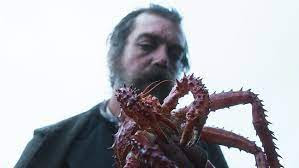 |
| Natasa Stork in Preparations to be Together for an Unknown Period of Time |
Lili Horvat's Preparations to be Together for an Unknown Period of Time is a clear eyed portrait of romantic obsession. A Hungarian born neurosurgeon, Marta, practicing in New Jersey becomes enamoured with a male colleague visiting from her motherland. They plan a rendezvous on a bridge in Budapest, but the guy is a no show. Not to be dissuaded, Marta moves to Budapest and stalks her intended. This 2020 film uses the streets and corridors of Budapest to create an architecture of longing in a labyrinthine search powered by a passion beyond reason. Highly recommended.Mark Mylod's The Menu has an interesting premise, but I found it ultimately unsatisfying. The script is clever and gives the film's players some tasty dialogue to chew on; which Ralph Fiennes and Nicholas Hoult take particular advantage of. However, the direction is anonymous and technically deficient, emphasizing the scenario's implausibility rather than its black comedy.
Jonas Akerlund's Spun, from 2003, is a grotesque comedy about methamphetamine addicts. Akerlund seems intent on rubbing his audience's faces into his grungy mise-en-scene, but the film's tone is all over the place. Animation sequences that seek to evoke the rush of a drug high come off as silly, as if the film was trying to gain a midnight movie cult following amongst stoners. Jason Schwartzman is miscast as a meth head, but Brittany Murphy, Mickey Rourke, and John Leguizamo have their moments.
Allan Ungar's Bandit is an affable chronicle of the career of Canadian bank robber Gilbert Galvan Jr. who pulled over fifty heists during the 80s and 90s. Josh Duhamel plays the miscreant who is continually donning wacky disguises while committing his crimes. The film apes Goodfellas and Catch Me If You Can, but aims for a cuter, more comic tone than those films; which is its main problem. Duhamel is pleasant throughout, but the film is too airbrushed and ingratiating for a crime drama. Nothing is at stake and there is precious little dramatic conflict or genuine humor.With Mel Gibson and Elisha Cuthbert.
Sarah Polley's Women Talking is a film I admired more than enjoyed. At times, the didactic nature of the script made me feel I was listening to feminist talking points rather than dialogue. However, the cast is first rate, lessening the impression that the characters are merely mouthpieces for Polley's ruminations. The film triumphs on a visual level, creating a particular world, and worldview, with an invigorating specificity. The film is talky, but I was never bored.
Veit Helmer's The Bra is a dialogue free, though not silent, charmer from the German director. Miki Monojlovioc stars as a train driver in Georgia who accidently snags a blue bra while on a run. He endeavors to find its owner, seeking, like the prince in Cinderella, the woman who is a perfect fit. This Chaplinesque feature is a well modulated and structured film that skirts, but generally avoids sentimentality and easy laffs. Featuring Denis Lavant and Paz Vega, the film is currently streaming on Amazon and is heartily recommended.






















